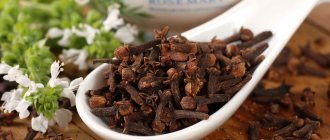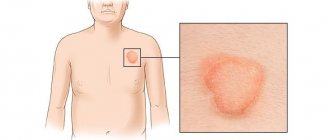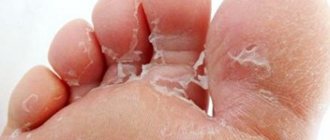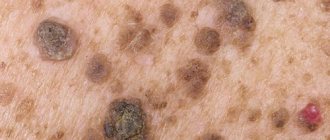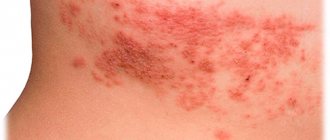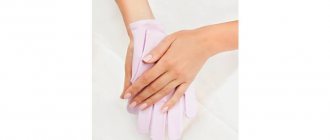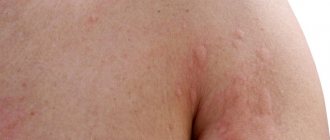Weeping eczema is a dermatological disease that develops against the background of impaired immunity and neuroendocrine regulation of the body. Its main manifestations are the presence of skin rashes in the form of bubbles (vesicles) with serous contents. It occurs in an acute form, affecting the arms and legs, but in severe cases of the disease with relapses it can affect other areas of the body.
About weeping eczema
Weeping eczema is an idiopathic, non-contagious skin disease characterized by an acute onset with severe, painful itching and inflammation. The disease occurs due to a number of external and internal factors. The task of a dermatologist is to understand the cause of eczema in a timely manner.
Wet eczema is a dermatosis that is manifested by the development of swelling, redness and various rash elements on the affected area of the skin. Competent and timely treatment will help get rid of all the symptoms of this disease. It is not contagious, so even with direct contact with the affected area it is impossible to get sick from it. The main cause of the rash lies in internal disorders of the body.
A dermatologist can easily identify this type of eczema by its characteristic rash. In the initial stage, redness of the skin surface appears, then the formation of tiny vesicles filled with liquid contents is observed. Subsequently, the blisters spontaneously open and release fluid, which is why this type of eczema is called weeping.
After opening and release of liquid, indentations remain. Purulent serous exudate periodically accumulates in them. The depressions are small, but their number is very large, because of this, the affected areas of the arms, legs, fingers and even the face constantly seem to be wet. In most cases, the disease occurs locally, but sometimes generalized eczema occurs.
First signs:
- unbearable itching;
- redness;
- peeling;
- swelling;
- bleeding cracks;
- many small papules;
- painful crusts after opening papules.
Treatment should be comprehensive, using external agents - ointments and lotions, immunomodulating drugs, hormonal therapy. The effectiveness of treatment largely depends on the patient himself, who must make changes to his usual lifestyle, follow a special diet and avoid contact with irritants.
How to care for your child’s skin before and during illness?
Weeping eczema in infants and older children damages the structure of the skin. Normally, the epidermis consists of several layers. The outer layer is covered with a thin, fatty film of phospholipids. In children it is especially fragile. The outer barrier protects against an unfavorable environment and pathogenic microbes.
When the disease occurs, the layer is damaged and the protective functions are weakened. The connection between epidermal cells is disrupted. The skin dries out. Why is this dangerous? Dryness causes unbearable itching, scratching inflammation, microtraumas serve as entry gates for pathogens and allergens. Proper care prevents the development of the disease and alleviates the condition during eczema.
It is necessary to exclude contact with external irritants. Synthetics, wool, pet hair. Clothing close to the body made of cotton, linen
It is important to wash children's clothes correctly. Washing with hypoallergenic powder
The machine automatically sets the additional rinse mode in hot water. Nowadays washing machines are sold with a built-in mode for washing children's clothes. The principle of care is skin hydration. Hygienic baths. Daily bathing without soap in non-chlorinated water at 37 C. Clean the city water supply with filters to remove chlorine or let the water sit for several hours. Swimming for no more than twenty minutes. Once a week, bathe with hypoallergenic shampoo and soap. Then dry the skin with a towel using gentle blotting movements.
Important! Baths are permissible only at the initial stage of the disease. If there are wounds, wet crusts, or pus, temporarily refrain from swimming
- Moisturizing baby creams. Children's medicinal cosmetics for skin care. Creams restore cells, eliminate redness, reduce itching, and heal cracks. Moisturized skin should be silky, soft, not rough.
- "Bipanthen";
- "De-panthenol";
- cosmetics series “Eared Nannies”;
- "My Sunshine";
- "Avencia";
- "Mustella."
Before introducing care products into use, a test must be carried out. Apply the cream to a small area and check the reaction after a few hours. If the skin is clean, the product can be used.
What is wet eczema
People of different ages suffer from weeping eczema, and each patient has his own history of the development of skin pathology. A wet rash is not contagious and is not an independent disease. It appears in people at a certain stage of the acute form of the disease:
- Idiopathic (true) has subtypes: dyshidrotic, pruriginous, horny, cracked.
- Microbial also has subtypes: plaque, peri-wound, mycotic, interdigital, varicose, sycosiform.
- Seborrheic affects the scalp under the hair, the skin on the chest and back (between the shoulder blades).
- Children may have symptoms of idiopathic, microbial and seborrheic pathology.
- Occupational - skin disease occurs from contact with allergens.
The doctor decides how to treat weeping eczema only after determining what skin disease caused the weeping eczema.
Symptoms of the disease
Weeping eczema has the following signs and symptoms:
- Initially, the skin becomes itchy and red.
- Vesicles (bubbles) with transparent contents are formed. If the liquid is interspersed with pus, it means that the eczema has been complicated by an infection.
- Watery bubbles burst, and erosions form in their place.
- The leaked contents, sterile or purulent, dry out, forming crusts under which the affected skin heals.
Weeping with seborrhea develops differently: first, red dense nodules appear on the reddened scalp. They then coalesce and transform into plaques covered with thick, greasy, scaly crusts, which, when removed, reveal a moist surface.
The location of the elements of an eczematous rash depends on the characteristics of the skin disease against which the weeping occurred. For example, if a person suffers from seborrhea, then weeping erosions will be observed on the scalp under the hair, behind the ears, in the folds of the skin. With a dyshidrotic type of pathology, wet elements will be present on the hands and feet, with a microbial type - on the skin between the fingers, etc.
Reasons for appearance
External and internal factors contribute to the development of weeping:
- genetic inheritance;
- hormonal imbalance;
- emotional stress;
- endocrine disorders;
- disturbance of local blood circulation.
The listed reasons provoke a change in the sensitivity of the skin to the effects of exogenous (external) factors. The latter may be of infectious origin (streptococci, fungus, staphylococci) and toxic-allergic (medicinal, occupational factors, gastrointestinal diseases).
In sick elderly people, weeping eczema on the fingers and other parts of the body often appears due to exposure of senile skin to subthreshold (minimally normal) non-allergenic irritants, which can be food additives, detergents, dyes, etc.
Diagnostics
A dermatologist is involved in determining the form, establishing the causes of weeping eczema, and selecting the optimal treatment for eczema. In the International Classification of Diseases, 10th revision (ICD 10), pathology belongs to the group of skin diseases and is encrypted with code L30.9.
Depending on concomitant diseases and suspected provoking factors, the patient may be prescribed consultations with an allergist, gastroenterologist, endocrinologist, immunologist and other related specialists.
A doctor can identify weeping eczema based on a visual examination, collection of complaints and the patient’s medical history. To clarify the diagnosis, the following are used:
p, blockquote 34,0,0,0,0 –>
- Scraping from damaged areas with further microscopic examination and culture. The study allows us to identify what pathological processes occur in the skin, determine the presence of pathogenic microorganisms and their sensitivity to antimicrobial drugs.
- Skin biopsy and histological analysis. It is used in severe cases, with frequent relapses, deep damage to the skin.
- Allergy tests (cutaneous or scarification). They make it possible to identify the allergen that caused the disease.
- Serological studies (determining the level of IgE responsible for predisposition to atopic diseases and specific antibodies, for example, to antigens of helminths and other parasites).
All patients are required to undergo a general blood test. Based on its results, it is possible to assume the allergic nature of the disease (by an increase in the number of eosinophils), to establish the activity of the inflammatory process (increase in the number of leukocytes, acceleration of ESR).
A biochemical study can identify problems in the liver, pancreas, and kidneys. Blood sugar levels can be used to diagnose diabetes mellitus or prediabetes (impaired glucose tolerance).
Using a general urine test, infections of the genitourinary system (cystitis, pyelonephritis and other pathologies) can be detected.
If there are concomitant diseases of the internal organs, the patient may be prescribed fibrogastroscopy (FEGDS), ultrasound examination of the abdominal and pelvic organs, computed tomography and magnetic resonance imaging.
Differential diagnosis
In order to prescribe correct and effective treatment, it is important to distinguish weeping eczema from other dermatoses (scabies, ichthyosis, dermatophytosis, toxicoderma, early stages of oncological skin pathologies) and various forms of eczema from each other.
Table - Differential diagnostic signs of weeping eczema
p, blockquote 40,0,0,0,0 –>
| Clinical signs | Eczema | Neurodermatitis | Psoriasis |
| Causes | Hereditary predisposition, contact with irritants | Genetic predisposition to atopy, food or household allergens | Autoimmune processes |
| Rash | A typical sign is polymorphism, in one area of the body nodules, vesicles, erosions, crusts, pigment spots, and oozing are simultaneously detected | Polymorphism is not expressed, severe redness of the skin is observed, small nodules, blisters, and excoriations (scratching) are formed. | Dry skin, peeling, plaques, scales, characteristic psoriatic triad (stearic spot, terminal film, blood dew) |
| Localization of rashes | On any part of the body, most often the hands, feet, face, neck, scalp | In the elbow and knee bends, on the back of the neck, on the face | Elbows, knees, chest, lower back, hips. Psoriasis often affects the hands, feet, fingernails and toenails |
| Dermographism | Red | White | Red |
| Itching | Intensive, secondary, occurs after the appearance of rash elements | Moderate to severe intensity, primary, precedes the appearance of rashes | It can be either mild or debilitating, depending on the severity of the disease, appears along with a rash |
Dermographism is a change in skin color in response to mechanical stress, caused by irritation of the walls of blood vessels, increased permeability of their walls and the release of mediators. It has important diagnostic value, as it allows one to evaluate the capillaries of the skin, the predominance of the sympathetic or parasympathetic nervous system (which plays an important role in the development of skin pathologies).
Local dermographism can be determined by running the blunt end of a glass rod (diameter 2 mm) across the forearm. After 10-20 seconds, a white or red stripe appears, which completely disappears after 1-10 minutes. In some diseases, red dermographism can persist for 1-2 hours and is accompanied by the appearance of blisters.
Causes
The exact cause of eczema is unknown, but the development of the disease is influenced by genetic predisposition, the presence of predisposing changes in the functioning of the immune system, allergic predisposition, functional changes in the nervous, endocrine and digestive systems.
Provoking factors may include:
- hereditary predisposition;
- hyperthyroidism;
- diabetes;
- bronchial asthma;
- exudative diathesis;
- changes in hormonal levels;
- ulcers, gastritis and other diseases of the digestive system;
- diseases of the nervous system;
- chronic infections;
- stressful situations;
- allergies to food or medications;
- physical and emotional stress;
- prolonged depression;
- constant contact with chemicals.
The pathology can affect people of all ages, and children are no exception. The tendency to disease largely determines the general health of the patient. The presence of foci of chronic infection, malfunctions of organs and systems of the body, contact with allergens, stressful situations - all these factors negatively affect the state of the immune system and become a trigger that causes the development of dermatosis.
General recommendations
Often skin disease is triggered by other health problems. For skin eczema, risk factors include endocrine diseases, kidney disease, digestive disorders, the presence of parasites, nervous disorders, and untreated foci of infection (sore teeth, tonsillitis, stomatitis). Before treating eczema, you need to say goodbye to the listed pathologies.
Weeping eczema
The disease develops mainly due to contact with an allergen. Therefore, patients with eczema on the legs should monitor their own lifestyle. To prevent the development of the disease, avoiding exacerbation, it is indicated:
- avoid contact with substances that cause an allergic reaction: detergents, cosmetics, perfumes;
- metals to which allergies are often manifested (chrome and nickel included in alloys of jewelry, fasteners on clothes, shoes);
- abstain from tobacco and alcohol, especially during an exacerbation;
- wear clothes made from natural fabrics;
- abandon woolen and nylon or synthetic socks and tights in favor of cotton ones;
- avoid heavy sweating;
- avoid nervous tension;
- Clean the house regularly.
If you have weeping eczema on your legs, it is not recommended to wet the affected areas. If a microbial infection occurs, you can wash with baby soap without coloring or aromatic additives.
A dermatologist can determine the cause of weeping eczema on the legs. The doctor will prescribe a treatment that is suitable for a particular patient in a particular case; treatment of eczema is prescribed in a comprehensive manner. Treatment measures include eliminating the cause of the disease, internal and external medicinal treatment, diet, physiotherapy and prevention of exacerbations.
Consultation with a dermatologist
Diet for eczema
By nature, eczema is an allergic disease. It is recommended to exclude foods that cause allergies from the diet, especially during an exacerbation.
Similar products include:
- citrus fruits and other yellow and orange fruits and vegetables;
- chocolate, cocoa products;
- coffee;
- honey;
- smoked meats;
- mayonnaise and ketchup;
- alcoholic drinks.
Regardless of the allergen that caused eczema, a plant-dairy diet helps treat the disease: cereals, green vegetables, fruits, dairy products.
Stages
Skin pathology has several stages of progression:
| Stage | Manifestation of weeping (wet) eczema |
| erythema | manifestation of primary signs of a dermatological disease, accompanied by redness and swelling of the skin |
| papular | Papules with clear boundaries form in the area of skin redness |
| vesicular | papules fill with a serous fluid component, thereby forming vesicles |
| getting wet | mature vesicles burst with an outpouring of exudate, thereby starting the process of weeping skin wounds |
| cortical | As the skin dries, the area of localization of weeping becomes covered with dry crusts |
| peeling | As the restoration of the stratum corneum progresses, dried crusts begin to peel off and fall off |
Weeping eczema is characterized by periods of remission and exacerbation; it is also possible for the disease to transition into a chronic form, in which the stratum corneum thickens and the skin acquires a blue-red hue.
Causes and signs of the disease
Eczema (atopic dermatitis) is an autoimmune non-contagious disease in which disruptions in the immune system are reflected on the skin in the form of redness and the formation of vesicles (small blisters) with watery fluid. Pathogenesis lies in the body's reaction to irritants. They can be internal and external. Eczema is often classified as an allergic disease. The rash is localized on the extremities, but can spread throughout the body, especially in advanced cases. The disease is characterized by three stages:
- Exacerbation stage. The skin begins to crack and peel, the blisters spontaneously burst, merging into one large wet wound. Then the inflammation begins to dry out and a crust forms.
- Remission. The symptoms disappear and the skin begins to recover.
- Relapse stage. Re-inflammation and rash formation occur. The lesion covers a large surface area of the body, pain becomes pronounced. The disease can become chronic.
Wet eczema on the leg varies in type:
- True. Difficult to treat, affects a large area of skin. The rashes are extensive and painful, accompanied by severe swelling. There is practically no remission stage.
- Contact. Triggered by food or chemical allergens. Occupational eczema occurs, which occurs from contact with strong irritants - reagents or household chemicals, depending on the type of person’s activity.
- Microbial. It develops rapidly due to the proliferation of pathogenic bacteria at the site of cuts and wounds.
The disease is provoked by many factors:
- genetic predisposition;
- hormonal imbalances;
- diabetes;
- disorders in the endocrine system;
- diseases of the gastrointestinal tract;
- hyperthyroidism;
- abuse of allergenic foods;
- bad habits;
- skin infections;
- chronic stress.
The causes of atopic dermatitis can overlap each other, enhancing the clinical picture of the disease. Before starting drug treatment, you need to undergo a full examination of the body in order to thoroughly study the problem and prescribe complex therapy.
Treatment methods
Treatment of weeping eczema on the legs consists of relieving unpleasant symptoms and eliminating the provoking factor. It is impossible to completely cure the disease. If the doctor's recommendations are not followed, an acute relapse is possible.
Before using medications, you should consult a dermatologist. To clarify the diagnosis, an analysis is taken by scraping the affected area of the skin. If the disease is of an allergic nature, in the laboratory it will be determined which aggressive allergen provokes the rash.
The main treatment methods include:
- taking antihistamines (Suprastin, Zodak, Zyrtec). They reduce sensitivity to the allergen, relieve itching;
- in case of a severe allergic reaction in a hospital setting, calcium-based desensitizing drugs are administered intravenously;
- sorbents (Polysorb, Enterosgel, Activated carbon) are used to remove toxins from the body;
- Anti-inflammatory drugs are used for external use. In mild cases, non-steroidal ointments (Diclofenac, Meloxicam) are used; in chronic cases, corticosteroids (Sinalar) are prescribed;
- antiseptic lotions with medicinal solutions of tannin, silver nitrate or boric acid are used;
- in case of infection, antibacterial therapy is prescribed;
- to restore intestinal functionality and treat dysbiosis, various enzymes are taken (Mezim, Festal, Linex, Hilak Forte);
- sedatives are prescribed (Persen, Novo-Passit) to reduce anxiety and irritability;
- It is recommended to take vitamins to improve immunity.
Symptoms of weeping eczema + photos of wet areas of skin
Clinical manifestations of weeping eczema are as follows:
- The first sign that distinguishes the weeping form from other eczemas is the appearance of vesicles and papules, which appear as fluid-filled bubbles standing on raised stands.
- Severe itching and redness - the patient constantly experiences sensations similar to a nettle burn, and the itching reaches such proportions that the patient’s sleep and mental well-being are disturbed.
- Localization - most often it is the hands, less often the legs. There are documented cases of weeping eczema even on the face, but this is an uncharacteristic manifestation of the disease and is quite rare.
- Signs of evolutionary morphism - any doctor in the diagnostic process always checks for the presence of this clinical sign. The bottom line is that all stages of eczema should appear in one area of the skin at once: crusts, erosions, papules and vesicles grow together and indicate a progressive disease.
- Spontaneous opening - manifested in the ability of papules to die off the skin and penetrate the exudate out. The dots may coalesce into areas, forming entire patches of oozing fluid from the skin.
- Weeping eczema is a symptom reflected in the English name of the disease weeping eczema. The formation of exudate into droplets similar to dew or tears is a characteristic feature of weeping eczema.
- Colored thickenings - if the disease has been advanced and has entered the chronic stage, then at the wound sites lumps will appear, rising above the surface of the skin. They are blue or red in color and are very flaky.
Weeping eczema
Treatment on the head, face and ears with medications and folk remedies
Wet eczema on the head covers mainly the scalp, which is clearly visible in the photo. Among topical preparations, it is worth noting the use of special antiseborrheic shampoos based on tar, as well as tar soap and other similar products. Their daily use is not limited only to the scalp, since wet eczema often spreads to the ears, neck, etc.
Antiseborrheic shampoo Schering-Plough Friederm tar
Natural oils such as coconut and burdock soften the scalp well, and for prevention, shampoos with zinc pyrithione and coal tar are recommended.
In addition, it is highly recommended to be exposed to direct sunlight for at least half an hour a day, as ultraviolet radiation is good for eliminating scaly rashes.
Treatment of wet eczema on the face requires special care to prevent changes in the quality of the skin in the affected areas after treatment is completed.
Full complex treatment includes the use of local remedies:
- Ointments: salicylic, sulfur-resorcinol, ichthyol;
- Healing and antiseptic agents: Bepanten, Nizoral, Videstim, Panthenol, Exoderil, Gistan, Naftalan, etc.;
- Birch tar;
- Antimycotic and antibacterial ointments (Hydrocortisone, Elokom, Ftorokort, Beloderm, Advantan, etc.).
Bepanten
Lotions with cabbage and potato juice, compresses and masks made from fresh cabbage and potatoes, as well as propolis oil, which is used to lubricate the skin, help well with wet eczema on various parts of the face.
Physiotherapy
In addition to medications, physiotherapeutic treatment helps with weeping eczema. Its task is to correct the response of the immune system, reduce inflammation, and relieve excitement of the nervous system.
For weeping eczema on the legs, the following procedures are prescribed:
- Electrophoresis with antihistamines.
- Phototherapy is irradiation with long-wave ultraviolet light. The method is often used to treat children; it does not require taking photosensitizing drugs.
- Laser therapy - this method treats erosions in weeping eczema; irradiation is carried out with a low-intensity infrared laser.
- Magnetotherapy.
- Darsonvalization - reduces itching and weeping.
- PUVA therapy (PUVA - Psoralen + UltraViolet A) - ultraviolet therapy with the photosensitizing drug psoralen. The method treats eczema and other skin diseases. Not everyone tolerates the ingestion of photosensitizers well, but now PUVA baths have appeared, where psoralen is dissolved in water. An effective method of treating eczema includes contraindications: pregnancy, increased sensitivity to light, melanoma, aphakia (lack of lens), severe myocardial pathologies, in which you cannot stand for a long time. Side effects occur in people with fair skin, patients with cancer, cataracts, and kidney failure.
- Electrosleep - calms the nervous system, which has a good effect on the patient’s condition.
- Acupuncture.
For weeping eczema, spa treatment in a dry coastal climate is indicated. Treatments include baths with salt, soda, and therapeutic mud.
Consequences
As soon as you discover any signs of eczema, you should immediately consult a doctor, and after he has established a diagnosis, begin its immediate treatment. Eczema is one of those types of diseases that develop very quickly and quickly become chronic, which provokes constant stress on the immune system and, accordingly, the appearance of severe complications.
Complications of wet eczema in adults
In adults, there are two types of serious complications:
- The addition of a bacterial infection and the development of purulent inflammation on the skin. It is a serious complication of eczema, which is manifested by the following symptoms: the appearance on the skin of blisters with purulent contents, which, when opened, form a weeping surface with an unpleasant putrefactive odor,
- increase in body temperature,
- deterioration in general health.
- Erythroderma is a widespread inflammation that affects almost the entire skin of the body.


